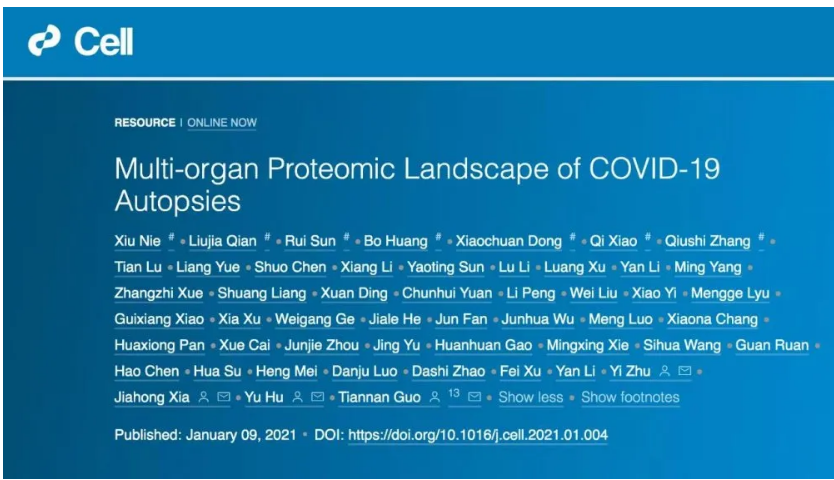The latest research paper titled Multi-organ Proteomic Landscape of COVID-19 Autopsies was published online on Cell by the team composed of Hu Yu, Xia Jiahong and Nie Xiu from the Union Hospital affiliated to Tongji Medical College of Huazhong University of Science and Technology and its collaborative team, the research group of Guo Tiannan from Westlake University, on January 9, reporting a panoramic view of protein molecules and their pathological changes in multi-organ tissue samples of severe patients with COVID-19 at the end stage.

The research team systematically reported the histopathological changes of seven organs, including the lung, spleen, liver, heart, kidney, thyroid and testis, of patients who died of COVID-19, and conducted mass spectrometric data sampling and proteomic analysis on the corresponding tissue samples of patients with and without COVID-19 through pressure cycling technology (PCT) and TMT tagging in combination with shotgun proteomics technology. A total of 11,394 human-derived protein molecules were identified and 5,336 differential proteins and several abnormal signaling pathways were found in the study, suggesting the coexistence of hyperinflammatory response and repair state in patients as well as the diversity of signaling pathways activated by different organs. By focusing on six proteins, i.e., viral receptors and proteases, transcription factors, cytokines (and their receptors), coagulation system-related proteins, angiogenesis-related proteins and fibrosis-related markers, the team speculated that the SARS-CoV-2 entered body cells under the mediation of receptors and proteases, hijacked the translation mechanism of the host and induced its inflammatory response through transcription factors, resulting in a hyperinflammatory state in the body and thus causing hypercoagulable state, microthrombosis, fibrosis, angiogenesis and other pathological processes. As the fibrosis mechanism of various organs of severe patients with COVID-19 had been stimulated, early intervention and prevention would be required for the possible "multi-organ fibrosis". In addition, the research team of Union Hospital first reported that the testicular tissue of patients died of COVID-19 had pathological changes such as seminiferous tubule damage, leydig cell reduction and mild lymphocyte infiltration (www.sciencedirect.com/journal/homepage: ). Based on that, the team conducted a further proteomic analysis and found 10 significantly down-regulated proteins in the testicular tissue, which were closely related to the inhibition of cholesterol synthesis and the decrease of sperm activity and leydig cell specific markers (INSL3), indicating that the germ cell function of severe male patients with COVID-19 is worthy of further long-term research.
The study analyzed the protein expression level of six receptors/proteases ACE2, CLEC4M, CD209, NPC1, CEACAM1 and CTSL that had been reported to be related to virus invasion, and found that ACE2 proteins did not increase significantly in the lungs and other organs of the patients with COVID-19 but instead reduced in the heart and kidney tissues, leading to the speculation that the ACE2 inhibitor is not an effective strategy for the treatment of severe patients with COVID-19. Cathepsin L (CTSL) was significantly highly expressed in lung tissues of patients with COVID-19 and participated in not only the endosomal pathway but also the activation of inflammasomes and other inflammatory responses. The highly expressed CTSL may have mediated the entry of the virus into the host and its hyperinflammatory state, suggesting that CTSL may well be a potential therapeutic target to block virus invasion.
During the outbreak of the epidemic in Wuhan, an autopsy team of 26 members including Xia Jiahong (Vice President), Nie Xiu (Director of the Pathology Department) and other researchers from the Pathology Department, Ultrasonography Department, Surgery Department and Internal Medicine Department was set up under the leadership of Hu Yu (President of the Union Hospital). The team carried out 30 cases of multi-organ minimally invasive autopsy under the guidance of Academician Bian Xiuwu. The research results have made significant contributions to the compilation of the pathology part of the COVID-19 Diagnosis and Treatment Plan (the Seventh Edition, Trial) and provided a basis for decision-making on the selection of a clinical treatment plan for severe patients with COVID-19.
The study systematically reported for the first time in the world the panoramic view of pathological changes of multi-organ protein molecules in severe patients with COVID-19 at the end stage, clarified the interaction of multiple organs in the case of hypoxia and immune changes caused by the novel coronavirus infection and revealed the pathological mechanism of multi-organ damage caused by the novel coronavirus, providing valuable resources for clinicians and researchers to have an insight of the molecular mechanism of multi-organ damage in critical patients with COVID-19 and laid a molecular pathological basis for the establishment of a more scientific COVID-19 diagnosis and treatment plan. Several potential drug targets have been proposed in the study, offering a clue for the development of new drugs and treatment methods.
Hu Yu and Xia Jiahong from the Union Hospital and Guo Tiannan and Zhu Yi from the Westlake University are joint corresponding authors of this paper. Nie Xiu, Huang Bo and Dong Xiaochuan from Pathology Department of the Union Hospital, Qian Liujia, Sun Rui and Xiao Qi from the Westlake University, and Zhang Qiushi from Westlake Omics (Hangzhou) Biotechnology Co., Ltd. are co-first authors.
This study is greatly supported by Westlake University and funded by the National Natural Science Foundation of China, the Key Special Fund for Public Security Risk Prevention and Control and Emergency Technology of the Ministry of Science and Technology, the Fundamental Research Funds for the Central Universities, the Tencent Charitable Foundation, and the Westlake Education Foundation.
Link to the original paper:
https://www.cell.com/cell/fulltext/S0092-8674(21)00004-0
